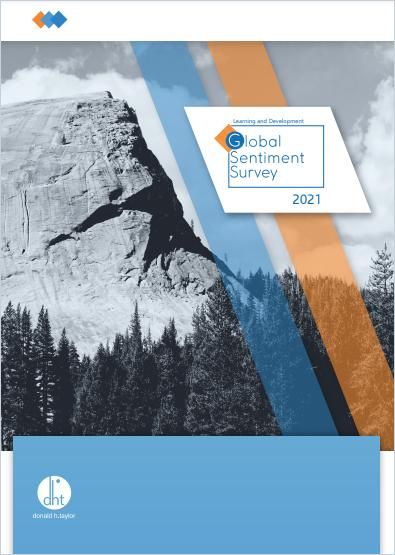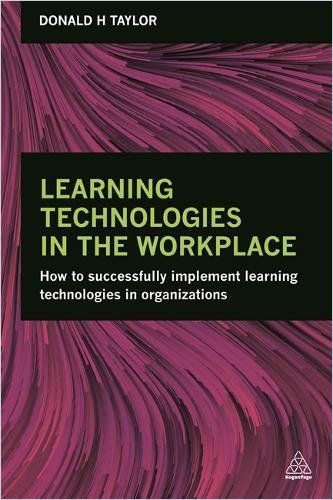“Go Watch Your People!”

Donald, the new Global Sentiment Survey highlights that in 2020, workplace collaboration benefited from employees embracing online conferencing and collaborating tools. Collaboration stopped being an ideal and suddenly became a reality. Is this a crucial part of the “shift from a focus on content creation to a focus on content management” you argued for in Learning Technologies in the Workplace in 2017?
Donald H. Taylor: 2020 was a shock. And a beginning. The question is: Do we take advantage of the changes? I say there are three stages of change that L&D goes through: adapt, adopt and advance. First, when there’s a shock, you have to adapt to new circumstances and you hope in the future you’re going to advance with a new way of doing things. In the middle, you have to adopt new practices consciously. Inevitably, in the adopt phase, you scramble to try to create new things. Some of them will be good, some of them will be OK. Some of them will create new bad practices, and many of them will replicate existing bad practices we already had.
That doesn’t sound as optimistic as I thought it would.
I don’t think that enough people have consciously been going through this adopt phase in the middle. We’re close to the idea that L&D adopts its new role in excellent content curation rather than just producing new content like courses, pieces of training, etc. But this applies only to a core of people interested in doing that, maybe 10% of respondents to the survey. Everybody else probably is going to carry on doing the same old thing. That’s the issue.
What is the next step to take for L&D professionals?
It’s vital to get out of the office. [Laughs.] I mean: metaphorically. Nobody is actually in an office right now. When you can, it’s good to sit down with people in the workplace, talk to them, see them and have conversations with them. This exchange of information, of experience, is vital even – and especially – for people working in virtual or hybrid teams.
Talk to people, listen to them, work with them!
Donald H. Taylor
Then, support them with their daily challenges; know exactly what they are doing. You have to understand what these people have to do, and on top of that, you need to build a relationship and trust. L&D needs to be embedded in the business. To do so, do not ask what training they want; do not even ask for problems to solve. It’s something you have to put a conscious effort into making happen by observing, doing and processing. And don’t stop with your company, your business: Observe what the significant trends are in the broader world as well. L&D has always been good at being insular, focusing on what we do well. Now, we need to get out and look at what the rest of the world is doing.
You mean frontline experience?
Yes. Go watch your people! When you observe somebody doing their job, you’ll see that they do it differently to how they would have described it when asked. To help people, you have to know how their problems arise. And they may come from any direction. You can’t tell which by just assuming to know.
Interestingly, at the same time, your 2021 report revealed that L&D professionals turned away from learning analytics and artificial intelligence (AI). But: While you can see that team chat software, etc., help collaborate, you have to measure and improve this collaboration. And that’s precisely what these tech tools do. Doesn’t this show that L&D professionals continue to act too “conservatively”?
I think there is some conservatism, but I’m not sure that point necessarily is evidence for it. Things naturally fall in the survey over time because the question is, “What’s hot?” Things move from being hot initially to becoming part of business as usual. Analytics and AI will come back, but not as a “hot” silver bullet. Instead, they will be used in the background for a learning experience platform, for example, or in the background for social learning. They will come back as an integral part of our learning world.

A key take-away from your 2017 book was: “Taking risks can help you implement new learning technologies. Work with your stakeholders and don’t be afraid to experiment and to compromise.” Now, as you point out, many have been forced to experiment. What are the pros and cons here?
We all need to be pushed sometimes. But 2020 changed everybody else’s perception of what’s possible. The term eLearning was invented around 1999, and it took about 20 years, up to January 2020, for 50% of training delivery to take place online. And then, within four months, 100% was online! That change was only possible because of the pandemic. It forced people to think about what you can do if you have to work remotely. And it was very effective.
Until about September of this year, I think L&D has a window to take advantage of this new situation, an openness in the business to doing things differently. If L&D doesn’t do that, it will be stuck with simply administering the emergency solutions that they put in place last year.
Donald H. Taylor
From the point of view of employees, who are to be increasingly upskilled and re-skilled – the top trend this year – 2020 was a very challenging year. Not only did many of them have to come to terms with new tools, but they also complain about constant availability, constant multitasking, and too many communication channels at once. How do trends like “learning in the flow of work” fit in here?
There is absolutely nothing wrong with the idea of learning in the flow of work. The problem is when we confuse learning in the flow of work with consuming content. People learn without content all the time. It may prove helpful for some people, for example, when L&D provides them with information bits through team chats every once in a while. But for all other people, unless they are ready for it and want it, it’s, as you say, a distraction. Learning and development people have to step back from the idea that their job is all about content. It’s about purpose, and about being in contact with the actual problem. We need to find a mechanism for getting to people when they are hot and ready to learn.
Do companies have to set up a system where distraction is minimized and where their employees can flee from constant content distractions to foster deep learning?
I love that question. And the answer is, yes. Work is far less about creating things than it used to be. Increasingly, work is about manipulating knowledge, which may result in the creation of things, but requires a process in which people have time to “deep work.” As a journalist, you’re a perfect example: You can’t write successfully if your dogs are barking all the time. You can’t focus if your supervisor bugs you with reports to check all the time. You can’t do a proper analysis of a database, and you can’t work out financial forecasting. You can’t do a whole range of things, the high-quality knowledge work that adds to an organization. I think it’s down to organizations to take the lead in carving out blocks of time for people and saying it’s OK not to be interrupted during this time. Now, when you’re doing that deep work, of course, you will also be learning in the flow of work.
How about the measurement here? And what role does L&D play?
Well, couple that with some way of reflecting on what’s been happening during that deep work, no-distractions period! If what you found out is valid, share it with other people in the organization. Citi is a great example. They had a 30-day project of encouraging people to share something every day. After the project ended, though, the employees kept on sharing! And anecdotally, people said it really contributed to the quality of their work. I am sure that consciously sharing important stuff will increasingly be part of the way we work in the future. And what L&D can do is facilitate that. That’s an important new frontier: L&D might provide infrastructure for sharing information, they may set up the protocols and the etiquette for doing it, they may make sure the managers are incentivized to make sure that people are doing it. They don’t have to – they probably cannot – create the content.

So, which three learning trends will play a unique role in the foreseeable hybrid workplace?
We’re moving towards a future that is unbound by the rules of past. Unlike previously, the people, the places, the organizations, the information, the markets that we work with will all change. And L&D is one part of that, but by no means the only part. We have a crucial role to play in making sure that organizations are ready for the future. To do so, L&D needs to unbind from previous ways of doing things.
We’re about sharing high-quality, helpful information – not the next course, which is very different.
Donald H. Taylor
We need to unbind ourselves while also deepening our understanding of how our organizations, the profession as a whole and the world we’re operating all work. Without that understanding, you won’t have the context of your job. And that means you won’t have a job for long.
What else should L&D professionals avoid within the next months and years?
They’ve got to avoid technophilia. Technology does not do an excellent job for you. It’s only ever going to help you do an excellent job. So, better make sure you’re doing a good job, then find the technology to support you doing it better. Don’t try to find a technology that will transform your life because it won’t. Second: Think less about learning and more about performance. That will shift your focus away from content towards people and processes. And as you take that step, third, your shift will be away from individuals – who are essential, the lifeblood of the organization – towards managers. Because managers are the most significant yet unsupported part of every organization, and the more we work with them, the better we know what we in L&D should be doing, and how we can do better as well.
About the Author
Donald H. Taylor heads the Advisory Board and Learning Professionals Network of the Learning and Performance Institute. As a recognised commentator and organiser in the field of workplace learning, he has spoken about, consulted on and written about learning technologies for more than three decades.
Next Steps
Read our interview on reskilling and upskilling with industry experts Edie Goldberg and Kelley Steven-Waiss:








